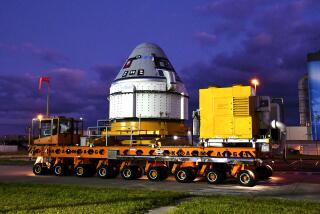NASA Sets Launch of the Space Shuttle Discovery for Sept. 29
- Share via
The launch of the Discovery has been set for Sept. 29, clearing the way for the first Americans to return to space in nearly three years.
The date was picked Friday after NASA Administrator James C. Fletcher was briefed in Washington by Rear Adm. Richard Truly, head of the shuttle program, on the results of a comprehensive flight readiness review at the Kennedy Space Center in Florida earlier in the week.
Some officials had hoped to launch the shuttle even earlier--possibly as soon as Sept. 26--but NASA delayed picking the date until questions about a tiny fuel leak could be resolved and the threat from Hurricane Gilbert had eased. By late Friday, the hurricane was pounding the coastline far south of NASA’s flight control center in Houston and no serious threat to the Johnson Space Center there seemed likely.
‘My Hat Is Off’
“I’m delighted to have reached this point and my hat is off to all members of the shuttle team whose tireless efforts have brought us here to the brink of America’s return to manned space flight,” Truly said in a statement.
No American has been in space since the Challenger exploded over Florida on Jan. 28, 1986, in the worst accident in the history of space exploration. Seven Americans died in that tragedy.
The Discovery is scheduled to lift off from the same launch pad during a three-hour launch “window” that begins at 6:59 a.m., Pacific time, with a landing at Edwards Air Force Base at 7:55 a.m. Pacific time on Monday, Oct. 3. There will be a public viewing area at Edwards for the landing.
Engineers at the Kennedy Space Center will spend today testing repairs of a small fuel leak in the Discovery’s engine compartment that turned up several days ago. Officials there said no problems are expected. The leak was the latest in a series of nagging problems that have plagued the Discovery since it was hauled to Launch Pad 39B on July 4.
Five previous launch dates have been announced, and then scrubbed, because of problems with the Discovery, which has been extensively modified since the Challenger accident. More than 400 changes have been made in the shuttle, and the solid rockets strapped to its side have been redesigned, so the Discovery that blasts off on Sept. 29 will be a very different bird from its predecessors.
After such a long interruption in the program, and so many changes in the vehicle, this flight will be almost like a maiden voyage. More than 3,600 media representatives have requested credentials to cover the launch. At the time of the Challenger accident, shuttle launches had grown so routine that the number of reporters at Cape Canaveral had dwindled to a few dozen.
Public Safety Concerns
Because of new concerns about public safety, most observers will be kept farther back from the launch than in the past, and a new VIP viewing stand that NASA recently erected near the launch control center will go unused.
The flight itself will be short--four days--and the primary goal will be to launch a sophisticated communications satellite for NASA. The $100-million Tracking and Data Relay Satellite, built by TRW Inc. of Redondo Beach, is identical to a satellite that was lost in the Challenger explosion.
All members of the five-man crew are shuttle veterans. Navy Capt. Frederick Hauck will be the Discovery’s commander and Air Force Col. Richard O. Covey will be the pilot. Other crewmen are George D. Nelson, John M. Lounge and David C. Hilmers.
More to Read
Sign up for Essential California
The most important California stories and recommendations in your inbox every morning.
You may occasionally receive promotional content from the Los Angeles Times.













